Affiliate disclosure: This post may contain affiliate links. Please see our Privacy Policy.
Homemade grape wine is a fun way to preserve homegrown grapes, but it can easily be made with store-bought juice.
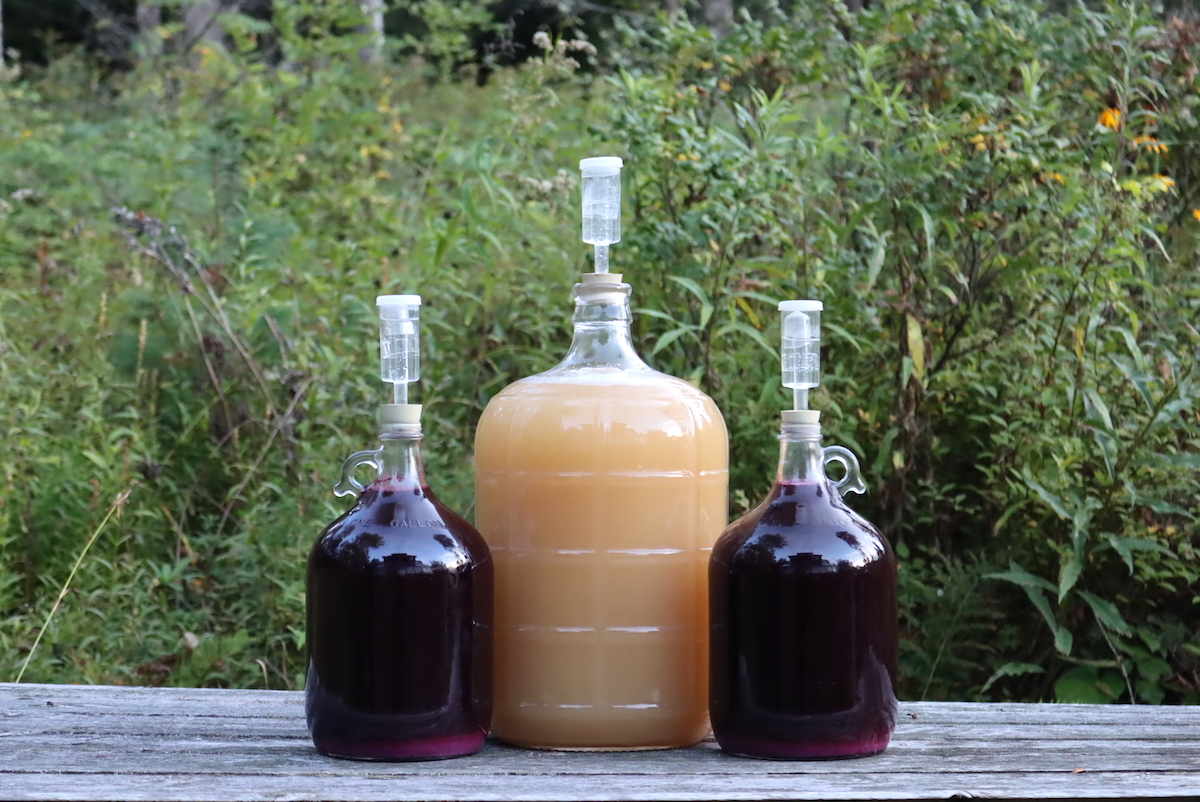
This tutorial on making wine from grapes is part of a winemaking series, and is oriented toward absolute beginners.
If you’re new to winemaking, I’d suggest you also read the other posts in this series, including:
- Beginners Guide to Making Fruit Wines– A step-by-step walkthrough of the entire winemaking process, perfect for those just starting out.
- Small Batch Winemaking – You can make micro-batches of wine, even as little as a single bottle. The equipment and methods differ when working with tiny amounts, and this section covers everything you need to know.
- How to Make Mead (Honey Wine) – The process for mead is similar to fruit wine but with a few unique considerations when working with honey. This guide will walk you through those specifics.
- Equipment for Winemaking– A rundown of all the tools and gear you’ll need to make your first batch of wine (other than your ingredients, of course).
- Ingredients for Winemaking– A comprehensive list of the essential ingredients for crafting your wine, excluding yeast.
- Yeast for Winemaking – With so many types of yeast to choose from, it can get overwhelming. This section simplifies things by breaking down the most common strains and how to choose the right one for your wine.
- Winemaking Recipes – Finding good recipes can be tricky, but I’ve put together over 50 recipes to help you get started on your winemaking journey.
- Meadmaking Recipes – Mead recipes are even harder to come by, but don’t worry—I’ve compiled a collection of them to get you brewing honey wine with confidence.
I also have instructions for making hard cider, pear cider (perry), and homemade beer, if you’re into other types of homemade drinks.
At this point, I have probably 20 different fruit, flower, and even vegetable wine (and mead) recipes up on the blog…but up until now, there were no grape wine recipes.
Why is that?
We make grape wines, of course, probably more gallons than any other fruit.
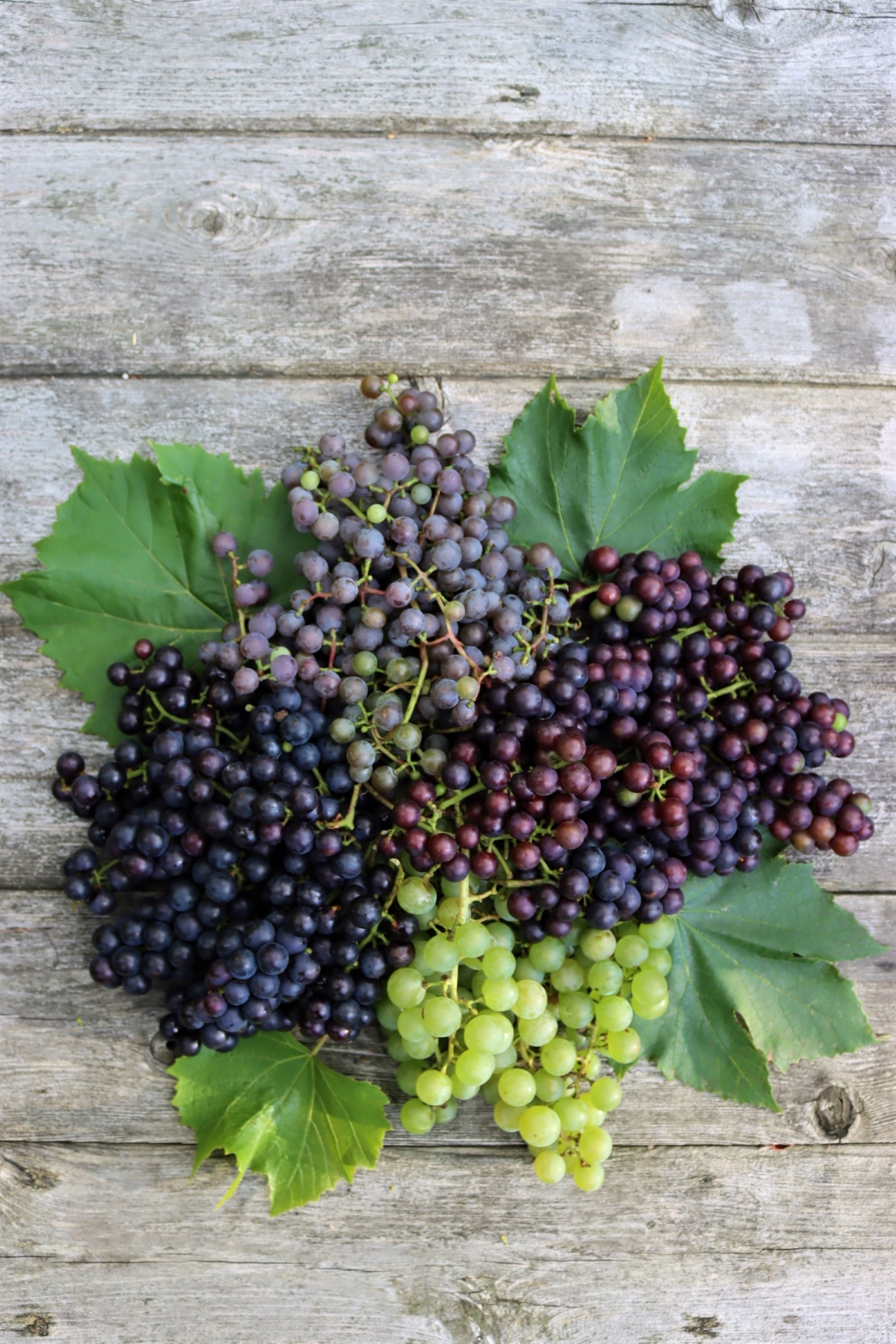
Growing grapes in zone 4 here in Vermont can be a challenge, but we’ve been doing it for more than a decade now, and there are plenty of cold-hardy grape varieties available these days.
We grow at least a dozen varieties of grapes and have them planted on just about every fence line on the property. As soon as a fence goes up, I’ll take a cutting from one of our most successful grapes, propagate it and get a new one working on that section of fence.
(Deer won’t jump a fence if they can’t see what’s on the other side, so it serves double duty on garden fences in particular.)
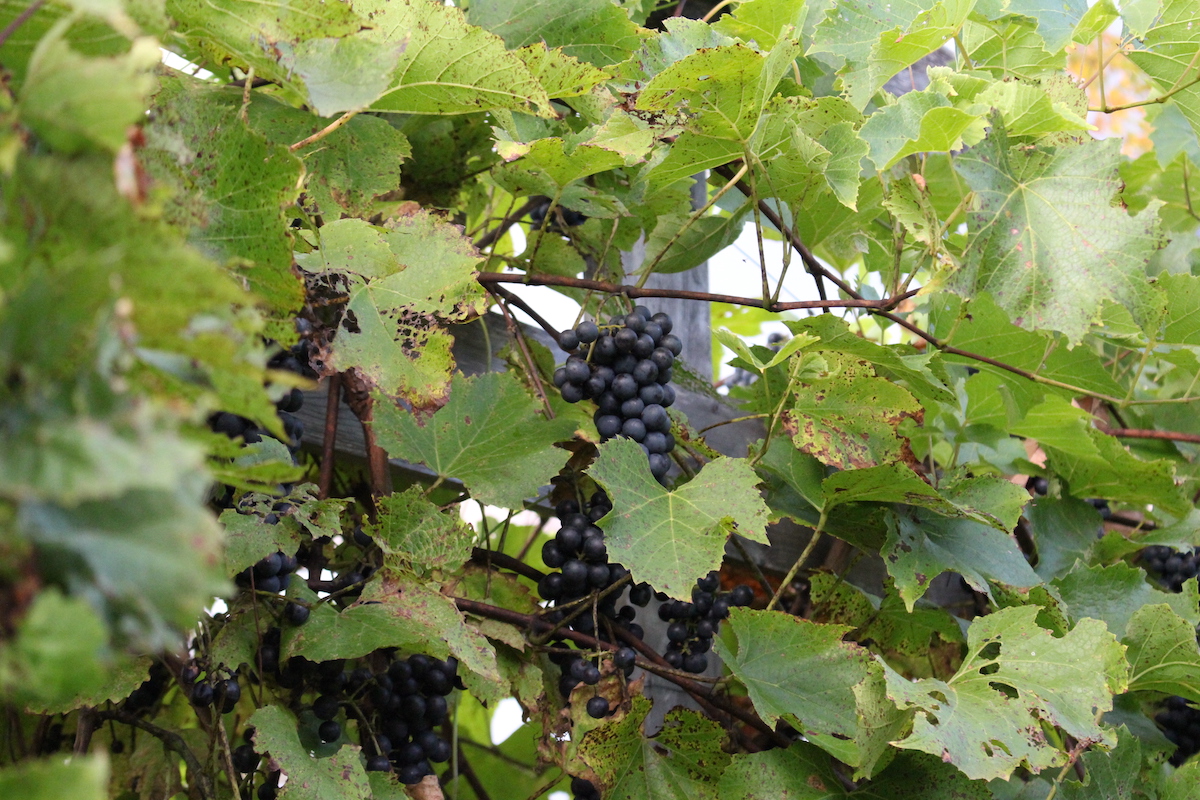
The grapes grow wild, and thrive without attention, and we’ll harvest somewhere between six and a dozen 5-gallon buckets in early September each year.
Much of it will be canned as grape juice, grape jelly, and old-fashioned (labor-intensive) grape jam, but they’ll still be bucket after bucket to be pressed for grape wine.
So why is there still no recipe for grape wine on the site?
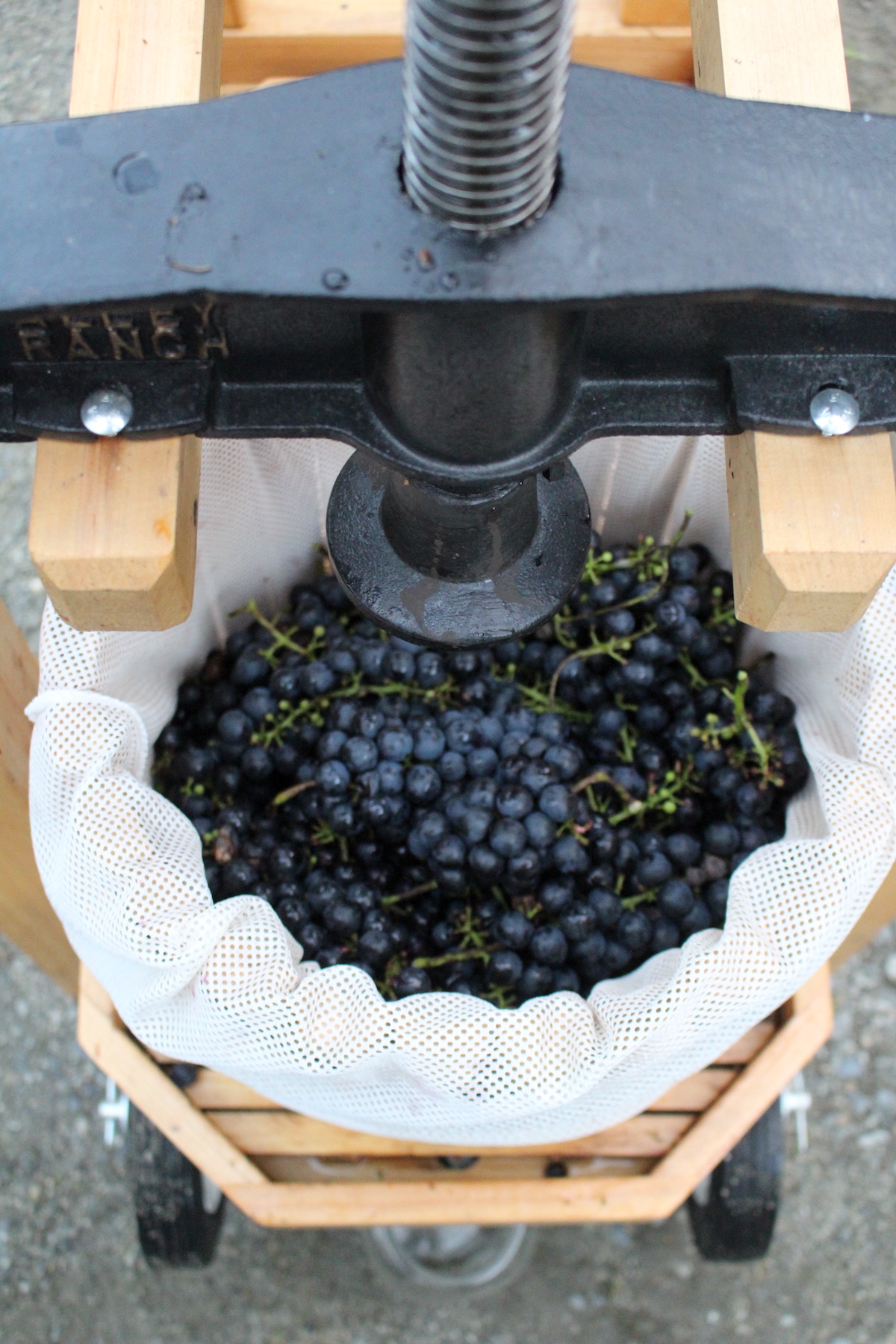
Believe it or not, making grape wine is tricky…and much more complex than making country fruit wines.
It’s less tricky if you invest in a lot of specialized winemaking equipment, a refractometer to measure the sugar levels in the grapes, a lab-grade titration kit to test for ph, sulfates, and all manner of other things.
Even though we make a lot of wine, I don’t actually have those things. It’s not that I don’t know how to use them, I spent four full years hunkered down in biology labs in college…it’s just that I prefer to make wine by taste, smell and observation…just like they used to back in the day.
(That, of course, is very hard to do…and it’s still a work in progress, but the wine gets better every year…)
So why is making grape wine more complicated than say, peach wine or blackberry wine?
The main thing is, grapes are incredibly variable in terms of their sugar content, acidity, tannins, and just about everything. It’s not just by variety, though, that impacts it as well.
How grapes are grown, when they’re harvested, really everything about their cultivation will dramatically impact the finished product. The same grapevine will not produce the same sugar levels year after year, because no two years are the same.
Simple things like the timing of the rains, the cloud cover, how the grapes are pruned or trained from year to year, really everything…impacts the finished winemaking characteristics. Grapes from the same vine might literally be twice as sweet this year as compared to last year, or half as acidic.
Grapes harvested from the same vines, just a day or two apart, could have dramatically different characteristics. As grapes ripen, their sugar content rises dramatically, and their acidity drops. There’s a sweet spot in there, and vineyards really have it dialed in. They harvest when the grapes have lost most of their tart acidity and gained maximum sugar…but haven’t spoiled yet.
(Peaches or blackberries, on the other hand, will vary slightly from year to year, but only by very small amounts…at least in terms of the things that are relevant to winemaking. Backyard peaches, grocery store peaches, whatever. They’ll all make a very similar wine in terms of ABV, tannins, acidity, etc. The main difference here is the aromatics, which comes from the quality of the peaches. But nonetheless, choose high-quality aromatic peaches that are super fresh…and you can follow the same recipe to make a great peach wine no matter where you live.)
In actual winemaking terminology, these variations give grape wine “Terroir” or a “Sense of Place.” It’s also another reason you hear people in movies say, “Ahhh, 1987… that’s a spectacular vintage.”
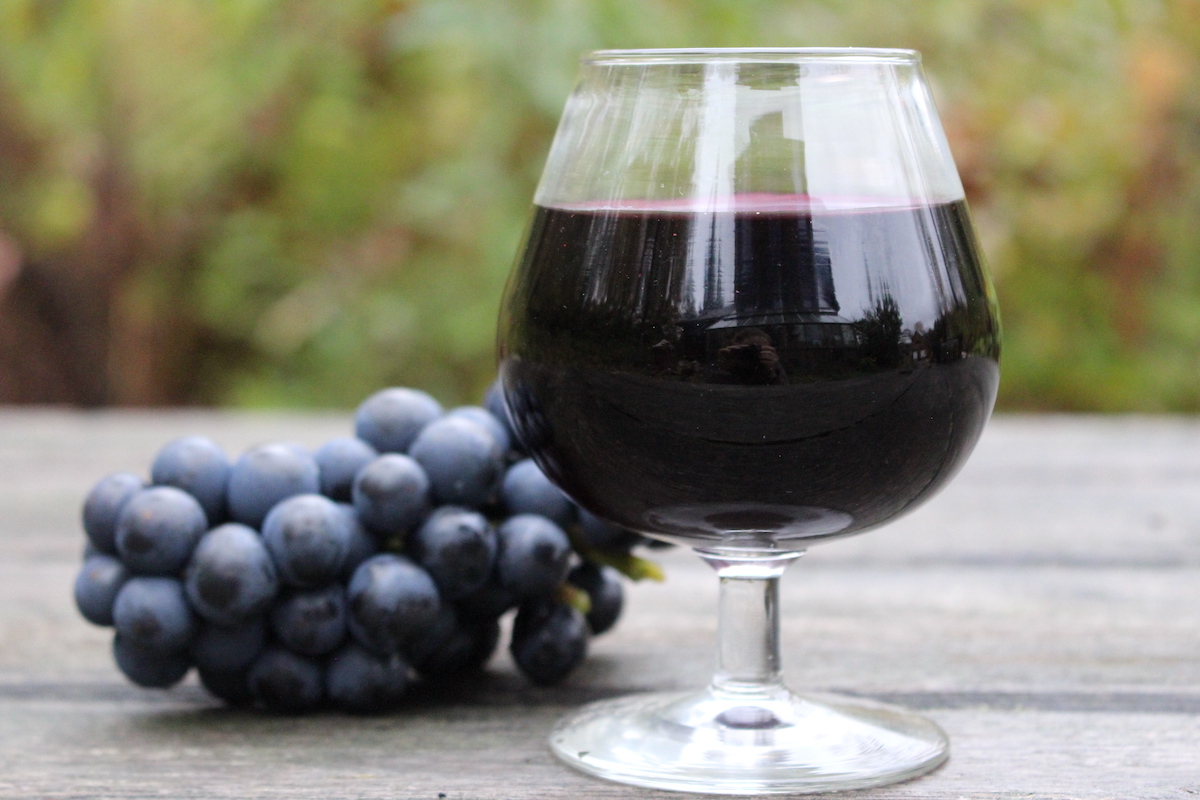
Ingredients for Winemaking
One of the reasons making grape wine is more complicated is that, in theory, grapes have everything that’s needed for making wine…without any other ingredients. The perfect grapes have enough sugar to bring the ABV to a stable level (and still leave residual sweetness), enough acidity to promote a healthy fermentation, the right balance of nutrients to feed the yeasts, natural yeasts on their skins, and enough tannin to provide balance and good mouthfeel in the finished wine.
At least in theory.
Fruit wines have none of these pretensions. Try making watermelon wine or pineapple wine, and you know you’ll need to add:
- Sugar (or honey)
- Yeast Nutrient (or Raisins)
- Tannin Powder (or black tea, or grape leaves)
- Acid Blend (or lemon juice)
- Winemaking yeast (don’t use bread yeast, that makes a nasty wine)
With grape wine, in theory, all you need is fresh pressed grapes. You don’t even need yeast, strictly speaking, because they have plenty of natural yeast on their skins.
In practice, vineyards add all sorts of things to their wine to create an elaborate cocktail that perfectly balances their wine, even if the grapes aren’t ideal. These days, it’s more an exercise in chemistry than agriculture.
They’ll use sulfites and potassium sorbate to kill the yeast off early to control the fermentation, so there’s residual sweetness, even if there wasn’t quite enough sugar in the grapes to start with. They’ll add acid and tannin, too.
You can even take away acid, believe it or not. Modern wines are not just made with yeast, they’re made with all kinds of microbes that work the juice over and change its chemistry. The “buttery” taste in a Chardonnay is created by Malto-Lactic Bacteria that convert harsher malic acid into creamy, buttery-tasting lactic acid.
It can get complicated really quickly.
If you’re new to winemaking, I’d strongly suggest making wine with a winemaking kit. The juice included is pressed from wine grapes, perfectly balanced, and then flash pasteurized so it can be shipped. You can see how the winemaking process goes, without having to worry about all the tiny details.
Basic Steps in Winemaking
So, let’s start with the basics. This is a really quick overview for those of you who have never made wine before.
- Prepare the Fruit – For grapes, that means stemming the grapes and then pressing the juice. With red wine, the skins are left in the fermenter for primary to add color and tannins. In white wine, just the juice is kept.
- Sterilize the Juice (optional) – These days, most people opt to chemically sterilize the fruit with Camden tablets. This kills off any yeast on the fruit, and means you’re only fermenting with added yeast from a packet. It’s a more dependable method, since package yeast is more dependable and consistent than wild yeast. That said, packaged yeast is also a lot more vigorous and tolerant of high alcohol levels than wild yeast. We don’t sterilize our juice because the cultivated yeast quickly outcompetes the wild yeast on the grapes in a matter of days, and then any that are left die out completely as alcohol levels rise. If you do sterilize the juice, you’ll have to wait 24 hours for the sulfites to evaporate before adding yeast so that you don’t kill your own yeast too.
- Add Yeast – The yeast choice is very important, as it actually imparts a lot of character and flavor to your finished wine. Some yeasts contribute fruity esters as a byproduct of their metabolism, and others ferment clean…and everywhere in between. The same juice fermented with two different yeasts will yield dramatically different results. The type of yeast also determines the residual sugars in the wine, based on its alcohol tolerance. If a yeast dies off at 13% ABV, it’ll leave a lot more residual sugars than if it dies off at 18% ABV. Whatever you do, don’t use bread yeast, it’ll make your wine taste like bread…that smell when bread is rising is actually the “bread smell” esters that bread yeast puts off.
- Primary Fermentation – For the first 7 to 14 days, the wine is in what’s known as primary fermentation. The yeast are working fast and rapidly multiplying, it’s often vigorous and creates a lot of sediment at the bottom of the fermenter. There’s little alcohol at this point, so primary fermentation is often done in an open bucket that’s just covered with a towel.
- Racking – After the initial vigorous fermentation is complete in “primary,” the wine is “racked” into a clean container. This is done with a siphon to avoid stirring up the sediment or “lees” at the bottom of the primary fermenter. If wine is left on the lees, it can develop off flavors.
- Secondary Fermentation – Once the wine is racked into secondary, it’s sealed with an airlock. That’s a one-way valve that prevents oxygen from getting in, but allows the CO2 produced during fermentation to escape. This prevents the alcohol that’s produced from turning into vinegar. Secondary usually lasts about a month.
- Tasting and Adjusting – After secondary, it’s time to taste the wine and adjust as needed. At this point, it’ll taste very “rough” as it hasn’t bottle aged at all, but it should give you a rough idea of the final flavors to expect. If it’s very dry, this is where you’d add some sugar or honey, or if it’s too sweet, you can consider adding some acidity to balance (or pitching in a more vigorous yeast strain to eat up more of the sugars). You can add more tannin or really anything that might be needed. Or, if it’s good, just go right to bottling.
- Tertiary Fermentation (optional) – If you have made adjustments, you’ll need to rack the wine into another fermenter for another couple of weeks to allow things to settle out before bottling.
- Bottling – To bottle, use a brewing siphon to move the wine into wine bottles and seal them with corks. Some people opt to sterilize their wines with potassium sorbate at bottling, which prevents additional fermentation in the bottle. I do not sterilize, I just make sure the secondary is long enough that the yeast has died off, and I’ll rack into tertiary if necessary to get any last activity out of the yeast.
- Bottle Conditioning – Once in the bottle, the wine will need to “bottle condition” for a minimum of 2 weeks before drinking (ideally, much longer, more like 2 months, or upwards of a year for some varieties).
Basic Grape Wine Recipe
Ok, so how does that translate into practice?
To make grape wine, you’ll need the following:
- 12 to 15 pounds of grapes (or about 1-gallon juice)
- Wine Yeast (Red Star Cote de Blanc yeast is a good general-purpose type)
Start by destemming the grapes and then pressing them. If making red wine, leave the skins in, for white, and filter out everything but the juice. Place in a fermentation bucket that can hold at least 2 gallons (it’ll foam up as it ferments).
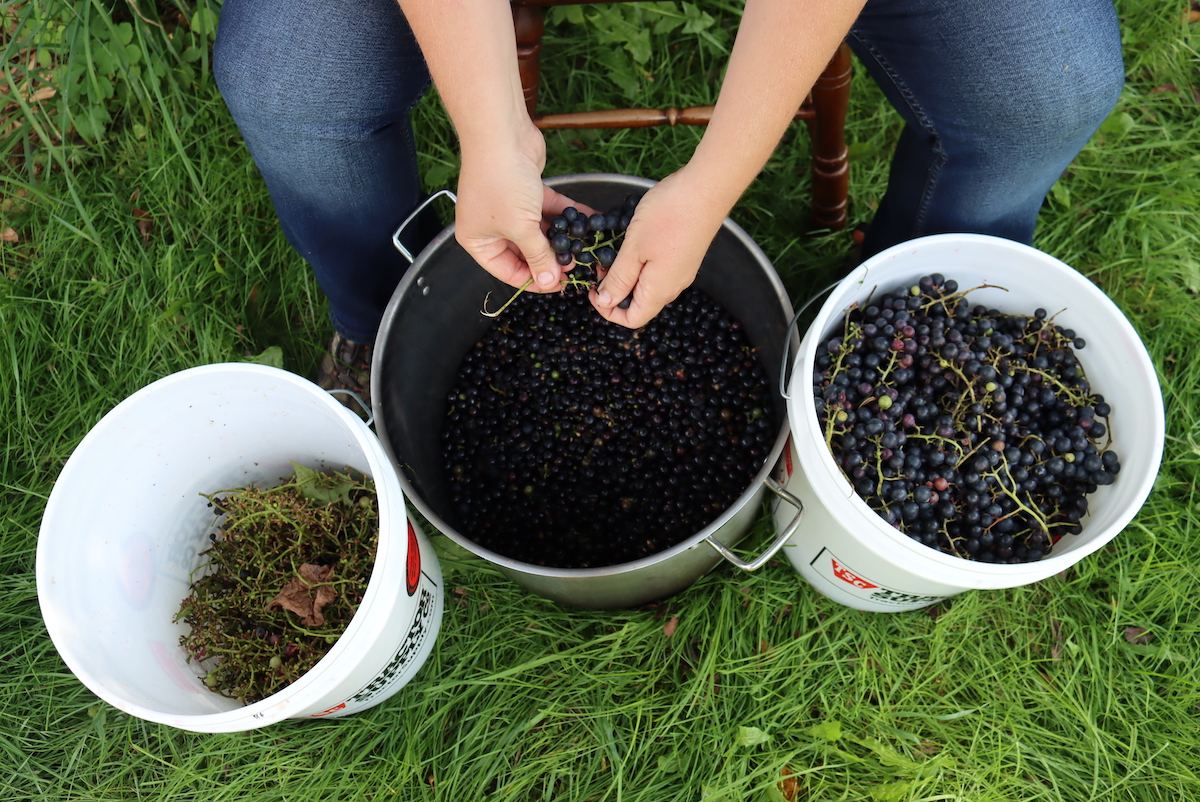
Dissolve the yeast packet in a small amount of water, wait 10 minutes for it to rehydrate, and then add the yeast to the grape juice.
Cover the mixture with a towel and allow it to ferment for 7 to 10 days in primary fermentation.
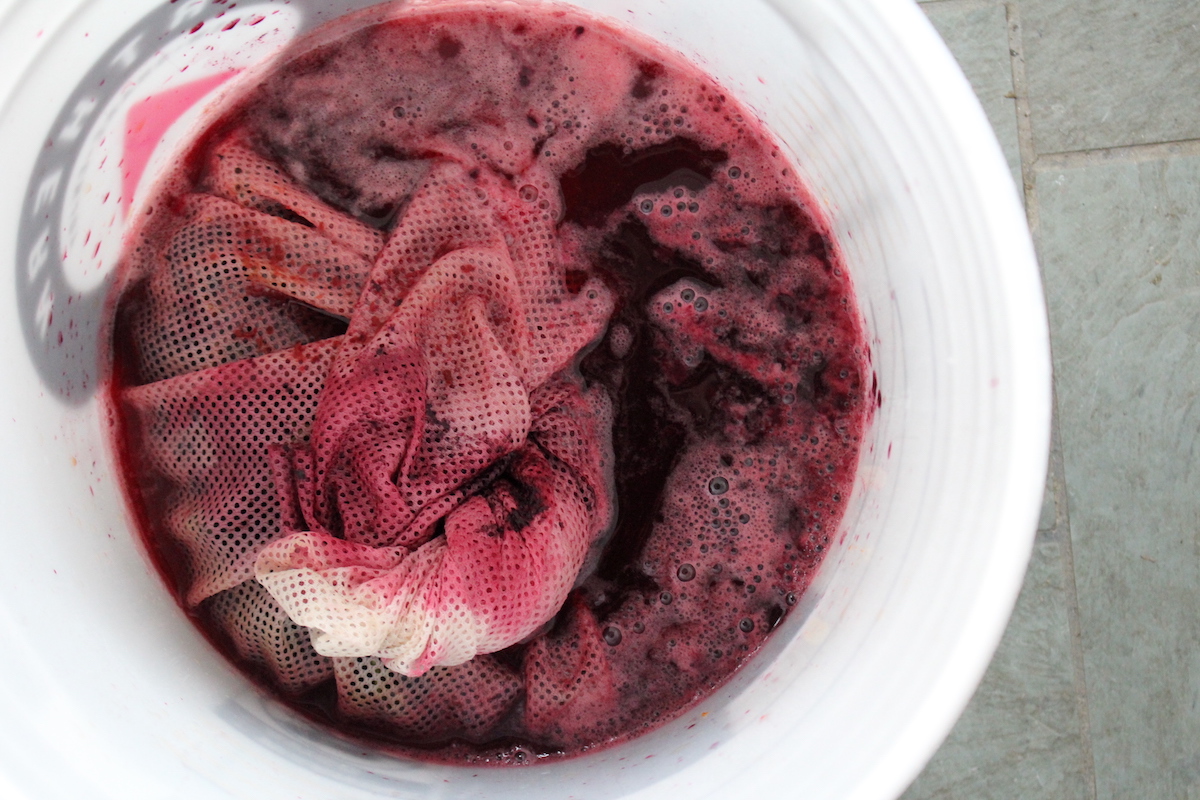
After the primary, use a brewing siphon to rack the wine into a narrow neck fermenter (carboy) that can be sealed with a water lock. Ferment in primary for another 4 weeks.
(Ideal fermentation temperatures for most yeasts are room temperature, usually 68 to 72 F, but check your yeast packet as some are different.)
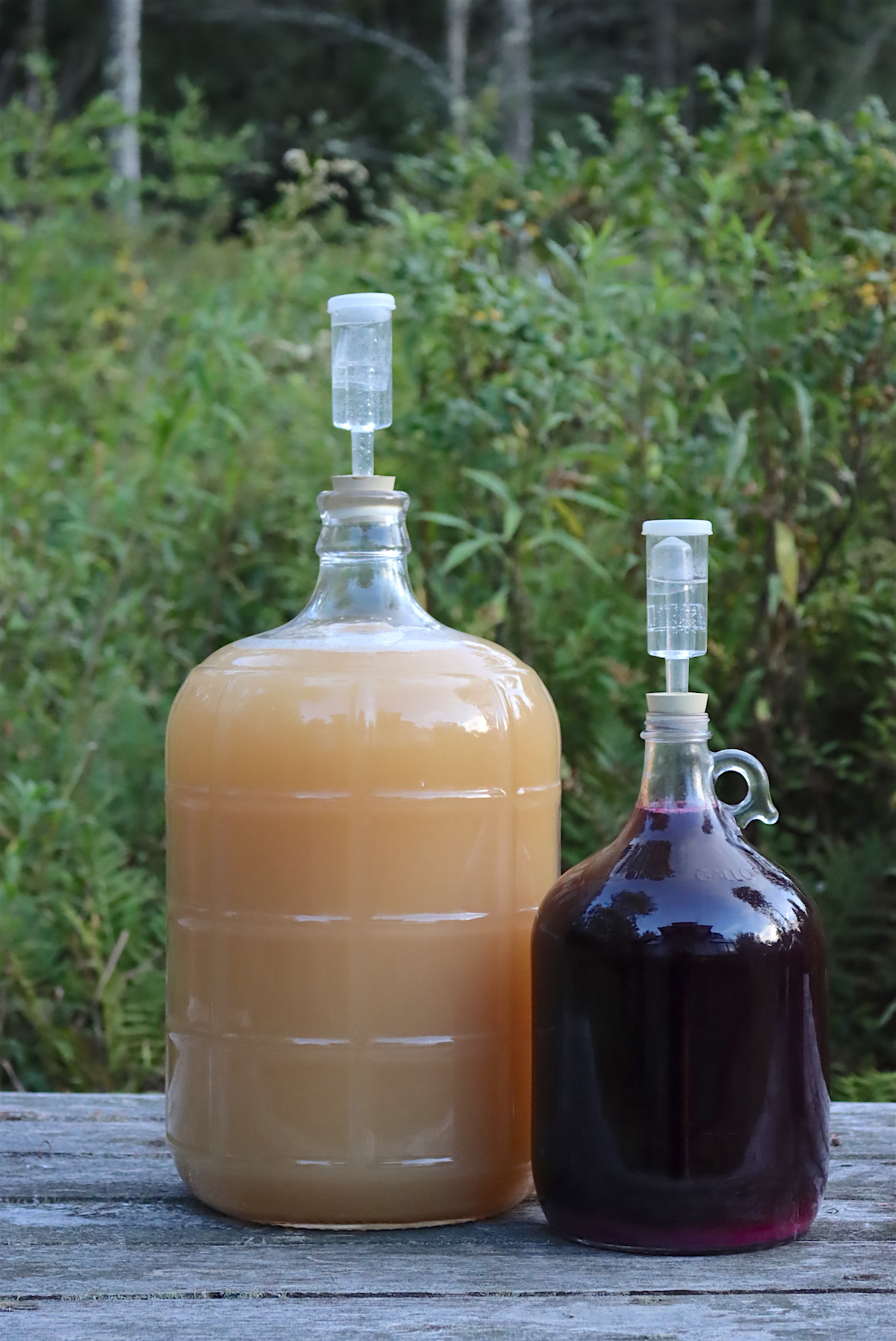
After 4 weeks, try the wine and adjust as necessary. If it’s good, it can be bottled, if adjusted, it’ll need to be racked into a tertiary fermentation for another few weeks.
If bottling, use a brewing siphon to move the wine into wine bottles and seal with corks. Bottle condition a minimum of 2 weeks before enjoying.
(You can also make wild grape wine with wild foraged grapes, but that’s ever so slightly more complicated since they’re low in natural sugar and extra high in acidity. Muscadine wine is also a bit different. I have a separate guide for both of those.)
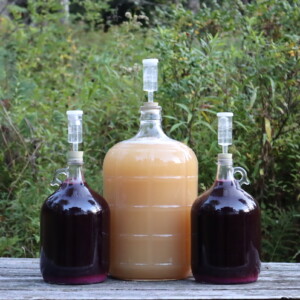
Homemade Wine (from grapes)
Equipment
- Air Lock & Stopper
Ingredients
- 12-15 pounds grapes, about 1 gallon of juice
- 1 packet wine yeast, Red Star Cote de Blanc or another suitable type
- Water, for dissolving yeast
Instructions
- Prepare the Grapes: Destem the grapes by hand, removing the stems (important for red wines). Press the grapes to extract the juice. For red wine, keep the skins in with the juice; for white wine, filter out the skins, leaving only the juice.
- Rehydrate the Yeast: Dissolve the wine yeast packet in a small amount of water and allow it to rehydrate for 10 minutes.
- Primary Fermentation: Pour the grape juice (with or without skins, depending on red or white) into the fermentation bucket. Add the rehydrated yeast to the juice. Cover the bucket with a towel and let it ferment at room temperature for 7-10 days. This will be your primary fermentation period.
- Racking the Wine: After 7-10 days, once the vigorous fermentation slows down, use a brewing siphon to transfer the wine into a narrow-neck carboy (secondary fermenter), leaving the sediment behind. If you're making red wine, you can place the skins in a brewing bag to make it easier to remove them later.
- Secondary Fermentation: Seal the carboy with an airlock and let the wine ferment for 4 weeks. Ensure it's stored in a room-temperature environment (68-72°F). During this time, the wine will continue to ferment slowly.
- Taste and Adjust: After 4 weeks, taste the wine. If it's good, it can be bottled. If adjustments are needed (e.g., sweetness or acidity), you can add sugar, acid, or more yeast and rack it into a tertiary fermentation for another few weeks.
- Bottling: Once you're satisfied with the flavor, use a brewing siphon to transfer the wine into wine bottles. Seal with corks.
- Bottle Conditioning: Allow the wine to bottle condition for at least 2 weeks before drinking. For better results, let it age for 2 months or longer.
Nutrition
Nutrition information is automatically calculated, so should only be used as an approximation.
Winemaking Recipes
If you’re interested in making wine from your own homegrown grapes, best of luck! It’s a rewarding process, but it can also be quite difficult. Your first attempt might not turn out perfectly, and you’ll likely need to make some adjustments after the secondary fermentation. However, each year will teach you something new, and with experience, your future batches will improve.
For beginners, I highly recommend starting with a wine kit that uses pre-purchased grape juice. This will give you a standardized base, ensuring the right balance of sugar, acid, and tannin. The kit will also come with yeast specifically suited for the juice, allowing you to focus on learning the winemaking process without worrying about the complexities of your own grapes’ chemistry.
As for recipes, there’s a fantastic (and free!) 300+ page PDF filled with custom winemaking recipes written by the legendary Jack Keller. He was a respected figure in the winemaking community until his passing a few years ago, and his readers compiled this incredible resource of his recipes. It’s an invaluable tool for anyone just starting out in winemaking.
There are quite a few grape wine recipes included in there, including:
- Niagara Grape Wine (pg. 56)
- Edelweiss Grape Wine (pg. 55)
- Berlandieri Grape Wine (pg. 44)
- White Grape Cherry Wine (pg. 38)
- White Grape and Raspberry Wine (pg. 68)
Fruit Wine Recipes
Fruit wines, as I said, are A LOT easier…and most recipes yield very consistent results. Here are some of my winemaking recipes:
- Blackberry Wine
- Blueberry Wine
- Raspberry Wine
- Strawberry Wine
- Cranberry Wine
- Elderberry Wine
- Pomegranate Wine
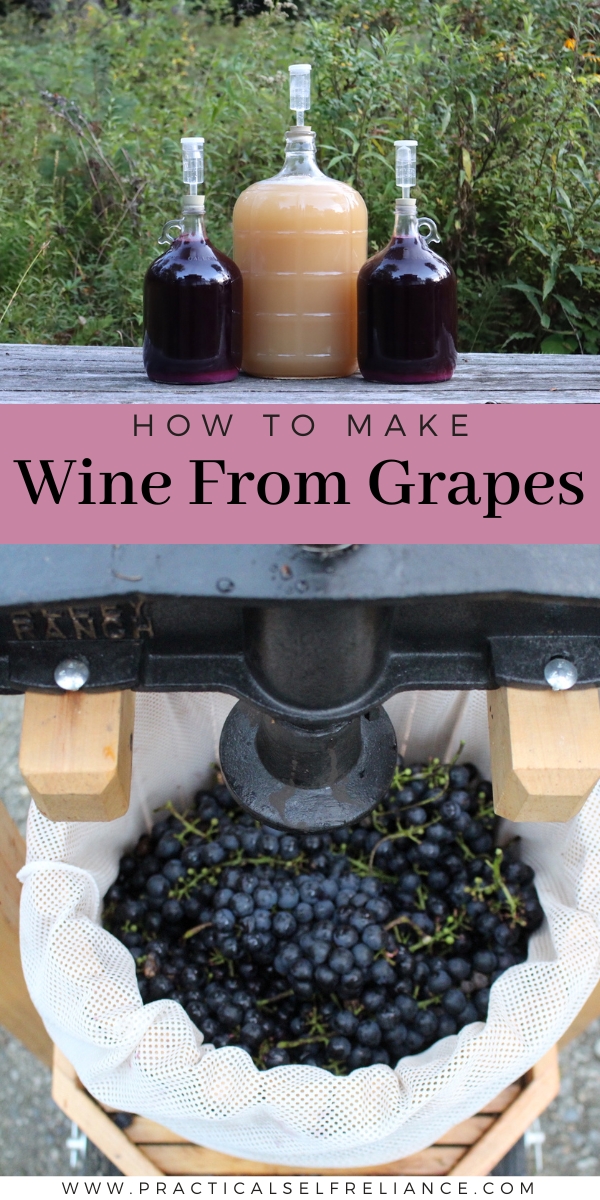



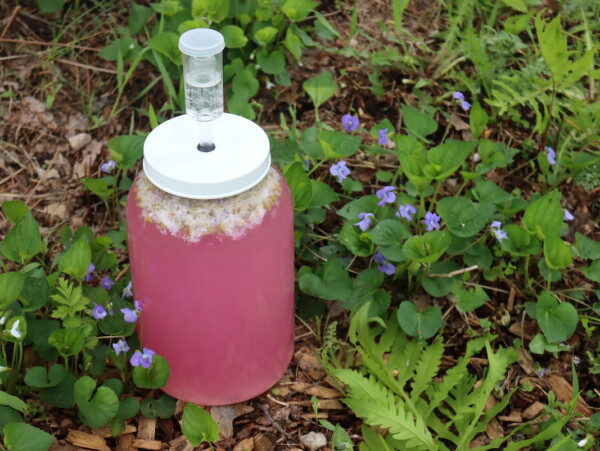










Hello! First, thank you for the great recipes 🙂 I was wondering if one could add spices like cinnamon or cloves to the wine during fermentation. Could it impede the process in any way? Thank you!
I have seen it done in other recipes. It would definitely be worth trying.
My dad made homemade wine when I was a child. I helped him press the grapes and bottle it. I would get to sip the finished product. I couldn’t remember the recipes but my cousin is actually a wine master in California. I found this article quite detailed and very informative and interesting!
That’s great. Thank you so much for sharing.